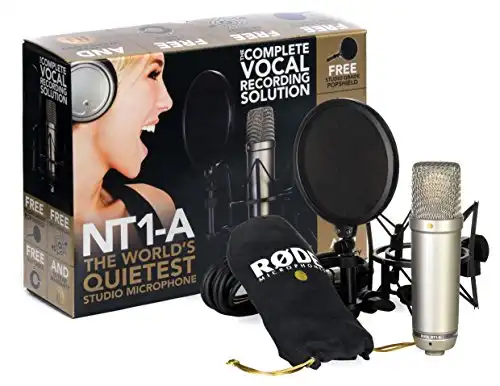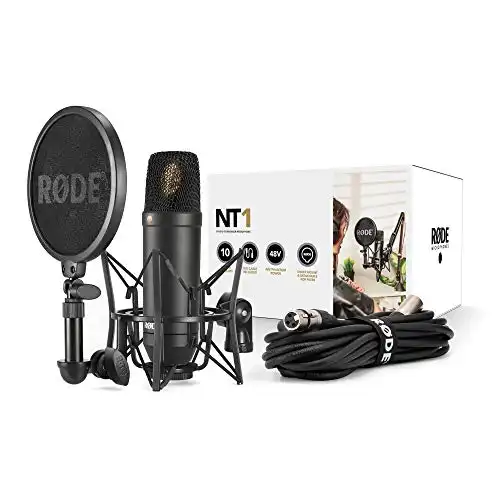If you’re searching for a microphone designed for voice recording, you have probably come across the Rode NT1 and its successor, the NT1A.
These large-diaphragm true-condenser microphones work exceptionally well on vocals of all types.
Let’s look at their features and determine which suits your needs better.

Table of Contents
Overview
The
With a self-noise of only 4.5 dB, the
And thanks to their extremely low self-noise, these mics are ideal for vocal recording and minimizing background noise.
Design
Both microphones are aesthetically pleasing and durable, but let’s see what that means for the recording process.
Rode NT1
Notably, the Rode NT1 features a large, 1″ gold-sputtered condenser capsule that can produce some of the clearest vocals you could wish for.
It also has a cardioid pick-up pattern, meaning it picks up most sound from in front of the microphone and less from the sides.
The
Rode NT1A
The
Both the NT1 and NT1A come with accessories: a shock mount, pop filter, and dust cover.
One of the world's quietest studio mics.
Audio Quality
Both the
With a frequency response of 20 Hz to 20 kHz, both microphones are suitable for recording vocals with exceptional clarity.
Namely, the
The
Additionally, the NT1A can sometimes sound slightly harsh in the top end, which is common in condensers of this price range.
Which is Better For Vocals?
As mentioned, the differences between the NT1 and NT1A are not so prominent.
The NT1 is the more balanced and natural-sounding microphone, and it could be more versatile in some cases. The NT1A sounds bright, sometimes even TOO bright, especially for female voices.
The
In general, the
In other words, the NT1A works particularly well with male voices, while the NT1 is suitable for various vocals.
User experience
Though online reviews praised both microphones, there are slight nuances. One person stated that the NT1 captures fewer mouth clicks than the NT1A.
One reviewer noted that, while it’s a matter of personal preference, the
Many users reported that the NT1A is fantastic at capturing instruments like acoustic guitars and vocals. Specifically, a user commented that the
Another user stated that the
Final Words
The
You may opt for the NT1 for a warmer, more natural sound and the NT1A for a brighter tone. Ultimately, the choice comes down to your preference, recording environment, and needs.
Frequently Asked Questions
What is the difference between a condenser and a normal mic?
A condenser microphone is more sensitive and has a wider frequency response than dynamic mics. Condensers are ideal for capturing subtle details in controlled studio environments.
Additionally, condenser microphones rely on external (phantom) power to work and tend to be more pricey.
Are condenser microphones good for recording vocals?
Yes, condenser microphones are the preferred choice for recording vocals. Thanks to their high sensitivity, condenser mics can clearly capture a wide range of frequencies.
They usually have a broader frequency response than other microphone types, making them suitable for recording different vocal styles or genres.
What is the Rode NT1 used for?
The
Is Rode NT1 good for ASMR?
Yes, it’s perfect for ASMR applications. The NT1 is a condenser mic with a cardioid polar pattern that can record quiet ASMR sounds with great quality. It also has ultra-low self-noise (4dBA), making it capable of recording subtle details.
Is the Rode NT1A good for vocals?
Yes, the
Does the Rode NT1A require phantom power?
Yes, it is a condenser microphone, meaning it needs external power to produce a signal. It requires 48v of phantom power to work. Most audio interfaces and mixers can supply phantom power to any microphone that needs it.
Is Rode NT1-A better than Shure SM7B?
The SM7B is a dynamic microphone, while the NT1A is a condenser, so comparing these two models is unfair. However, the NT1A is more prone to capturing background noise than the Shure SM7B.
The choice between these two ultimately depends on your desired recording style.
What’s the difference between Rode NT1 and Rode NT1A?
The difference between the NT1 and NT1A is minimal. They differ in sound because the
The mid-highs are also slightly more exaggerated in the NT1A.

